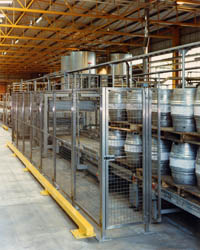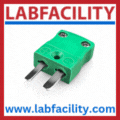
Posted to News on 16th Mar 2007, 13:52
How to design guarding for food and drink machinery
Jeremy Procter, Convenor of the European Standards Committee responsible for Machine Guards, and Managing Director of Procter Machinery Guarding, explains how to set about designing guarding for machines used in the food and drink industries.

Consider these Health and Safety Executive (HSE) statistics from 2005/06 relating to injuries in the food and beverage industry: four fatal injuries, 1084 non-fatal major injuries and 6208 over-three-day injuries, giving a total of 7296 injuries. Moreover, the figure of 1775.4 reported injuries per 100,000 employees is one of the highest of all industries - and more than double the average rate for all industries (563.0).
Thanks to an ongoing initiative between the HSE and the food and drink industries, known as the 'Recipe for Safety', the injury rate has fallen by over one-third since 1990/91. Nevertheless, there is still scope for improvement, especially in some sectors where injury rates are around five times higher than in the best performing sectors.
Machinery is one of the main causes of injuries, both fatal and non-fatal. A high proportion of machinery-related injuries occur in the production area, and often the injuries occur when there is inadequate guarding or a complete absence of guarding. Guarding design is therefore crucial in the battle to improve safety.
Important differences
Something that is not always appreciated, however, is how guarding for food and drink production machinery differs from guarding for other types of manufacturing equipment - and it is not just a question of using stainless steel and sealed interlock switches.
One of the characteristics of the food and drink industry is that frequent access is required to assist product flow, clear blockages or spills, and carry out cleaning. Indeed, there are two distinct categories of cleaning: in-shift cleaning that essentially takes place as part of the production process, and more thorough end-of-shift cleaning. Whereas manufacturing production equipment can typically be fitted with removable guards to provide access to danger zones for cleaning during shutdowns, food production equipment guards must provide means of rapid but safe access for in-shift cleaning, assisting product flow, clearing blockages, or any other activities that are considered to be part of 'normal operation'.
Another differentiator between the food and drink industry and other sectors is the nature of the hazards encountered. While most manufacturing equipment hazards relate to powered motion and electric shock, the food and drink industry has these but with the addition of hazards relating to stored energy. These include hot surfaces and parts (including product), cold items, vacuum, steam, hydraulic systems, pneumatic systems and pressurised atmospheres. The design of guarding and the associated interlocks therefore needs to take account of these, perhaps incorporating time delays or temperature sensors to allow items to cool down (or warm up), or interlocks to ensure that pressures are equalised before access can be gained. In some cases it may be appropriate, for example, to include restraining catches on doors covering pressure zones so that the doors will not be blown wide open if they are unlatched prematurely.
Guard design
With regard to the design of the guards themselves, because of the frequent access required, fixed guards should be avoided, while hinged guards are preferred to removable guards so as to avoid the guards being refitted incorrectly. Again, the requirement for regular access implies that the guards should be designed to be opened as quickly and easily as possible, but without compromising their safety function. Stainless steel is the preferred material for guarding, though the precise grade has to be checked against the foodstuffs being processed and the cleaning agents that will be used (both of which can be remarkably aggressive). Aluminium, clear polycarbonate and other plastic and plastic-coated components can also be used where appropriate.
Ledges, crevices and other 'bug traps' should be avoided, and all box sections closed; corners should be radiused wherever possible. Both the guarding framework and the guards themselves must be suitably robust so that they will cope with the frequent opening and closing, remembering that guards must not be overly heavy if operator fatigue is to be avoided. Interlocking devices need to be fully sealed, easy-clean devices such as coded magnetic safety switches, and it should be noted that sealed high-integrity light curtains might prove to be an appropriate alternative under certain circumstances where very rapid access is required routinely.
Dust, fumes and noise
There are two other aspects of guarding that are particularly applicable to machinery for the food and drink industry: dust/fume extraction and noise reduction. Dusts and fumes can be particularly hazardous to health or even explosive; these must therefore be removed and the guarding system is often designed for the fitment of extraction. If noise is a problem, which it often is with packaging lines, suitably designed guarding can often be used to reduce the noise emitted to an acceptable level. The Control of Noise at Work Regulations 2005 came into force in April 2006 and, by law, employers must assess and identify measures to eliminate or reduce risks from exposure to noise so as to protect employees' hearing. A free Food Information Sheet, reference FIS32, 'Reducing Noise Exposure in the Food and Drink Industries', is available from the HSE.
Machinery for the food and drink industry has to be CE marked in line with the requirements of the Machinery Directive, though specifiers and designers need to be aware of all of the relevant standards with which the machinery should comply, such as: BS EN ISO 12100-1:2003 (Safety of machinery - Basic concepts - General principles for design - Part 1 Basic terminology, methodology); BS EN ISO 12100-2:2003 (Safety of machinery - Basic concepts - General principles for design - Part 2, Technical principles); BS EN 953:1998 (Safety of machinery - Guards - General requirements for the design and construction of fixed and movable guards); BS EN 294:1992 (Safety of machinery - Safety distances to prevent danger zones being reached by the upper limbs); and BS EN 811:1997 (Safety of machinery - Safety distances to prevent danger zones being reached by the lower limbs).
Other food industry product-specific standards, some published, others still drafts, cover safety and hygiene requirements for everything from dough mixers and slicing machines to vegetable peelers and pie and tart machines. In addition, the HSE has a number of fact sheets that give guidance relating to the safeguarding of particular types of machinery, such as pre-formed rigid container packaging machines, palletisers and depalletisers, and flat belt conveyors used within the food and drink industries.
Track record
Clearly machinery guarding for the food and drink industry is a specialised area, but one where correct design can help to minimise access time and reduce downtime, as well as improving the overall machinery safety. Procter Machinery Guarding has been designing, supplying and installing bespoke guarding for the food and drink industry for over 25 years, with each project undertaken in such as way as to meet the needs of the customer as well as the latest HSE requirements and all current UK and European legislation. CAD (computer-aided design) and CAM (computer-aided manufacture) are used to ensure that the guards are an accurate fit on the machinery and that they can be installed as quickly as possible. While many of the guards are supplied for new machinery, custom guarding can also be supplied to fit existing machinery such as conveyors and packaging lines.
To discuss any requirements for machinery guarding in the food and drink industry, either for new projects or existing plant, please email [email protected] or telephone +44 (0)2920 882222.




